“Not Your Grandmother’s 4-H”
But the principles of head, heart, hands and health still thrive in Headwaters.
Nice. Nice kids.
There would be no more fitting description of the children and youth observed over the long 2019 season of wholesome 4-H activities in Peel Region and Dufferin and Wellington counties. All the kids are nice. Very nice. All the time. Even when nobody’s watching.
4-H is an agricultural, community-based nonprofit youth organization. The four Hs stand for head, heart, hands and health, and every meeting these four words guide members to commit to clearer thinking, greater loyalty, larger service and better living for their club, their community, their country and, in a recent addition to the pledge, their world. They mean it.
In early spring 2019, a pale sun, setting precipitously, painted a pastel sky above the rolling, freshly greening countryside of Mulmur. Swallows swooped and darted through gaps in barn slats, a happy dog yapped, sleepy cattle bawled. It was rural, it was real, and it was striking. It was a happy time, before Covid-19 was even imagined.
On a hard-working farm, two dozen members of the Dufferin 4-H Beef Club and their leaders were ranged in a ragged circle on the rutted earth, wrapping up the season’s first meeting. The kids were there learning to raise, show and judge heifers – young female cattle – and to acquire the arcane terms – underfinished, a good top line, and stands on a more correct set of feet and legs – to describe the qualities of beef cattle and the correct ways to communicate a critique as a judge. “Say it in a nicer way,” a leader suggests. “Say ‘lacking in overall eye appeal.’ No one wants to hear that their cow is ugly.”
Lanky lads in denim and girls in ponytails and pink hoodies stood side by side, ending the two-hour meeting by earnestly reciting the club motto: Learn to do by doing. They recognized and thanked the evening’s hosts with applause, set the time and place for the next meeting, then retired to the tailgates of mud-streaked trucks for snacks and happy banter.
Six meetings and a final event to honour their achievements stretching from early spring to fall made the beef club season, and all the meetings finished this way – circled, casual, country and unrelentingly, genuinely nice. Across 4-H, the venues and clubs varied, but the philosophy – and the nice – never did.
The beginnings
4-H was founded in the United States in the early 20th century as a means of encouraging young people, who were considered more open than adults to experimenting with new agricultural ideas, to bring about change by sharing new developments with older farmers. The organization was also a way of helping rural kids connect their formal, often theoretical, classroom education with the hands-on learning they experienced at home.
Independent 4-H organizations now exist in more than 70 countries. The first club in this country was founded in Manitoba in 1913, and 4-H in Canada now boasts about 23,500 members, more than 350,000 alumni and about 8,500 volunteer leaders spread over 1,900 clubs in all provinces. The clubs view themselves as a complement to, rather than a competitor with, other youth organizations such as the Boy Scouts and Girl Guides, which often focus on a more urban demographic.
Shannon Benner, chief executive officer of 4-H Canada, was raised rural but wasn’t a farm girl or a 4-H member. She has no box of fading agricultural show ribbons in the back of a closet. “I wish I did,” she said with a laugh.
Benner leads a 4-H in transition, trying to break from the dated stereotype of farm kids doing farm stuff: fresh-faced girls in crinolines baking pies, jug-eared boys with brilliantined hair beaming beside a red-ribbon swine.
“We’re trying to change that perception,” she said. “We’re not your grandmother’s 4-H anymore. What is relevant to 4-H today is very different from what was relevant when 4-H started. We talk a lot about science and technological progress. About STEM [science, technology, engineering, math]. The connection between science and innovation in agriculture is the natural next step.” Phrases such as “sustainable agriculture” and “food security” pepper today’s 4-H literature.
For some people, the terms “science” and “food” are mutually exclusive. Put together, the two words can conjure up unpalatable thoughts of frankenfoods, big pharma and agribusiness. 4-H does embrace “pillar partners” in corporate agricultural and scientific research, but “our approach is to enable young people to have access to all perspectives,” said Benner. “To educate them to understand all the different parties at the table and let them decide.”
4-H is changing. “We’re trying new club formats to engage people,” noted Benner. “You don’t need to live on a farm to care for an animal, to have that experience.” A host farm, as well as an animal, can be found for urban kids who want to join sheep club or raise a calf or pig.
In Ontario, 4-H associations are generally organized according to counties and regions. In Peel Region, which encompasses Brampton and Mississauga, as well as rural Caledon, the Peel 4-H Association is actively trying to attract more urban kids. The same is true in other similarly mixed demographic areas.
Under the umbrella of each county or regional association are a great many activity- and interest-specific clubs, each with a minimum of six members and at least two leaders. For an average annual fee of about $95, Ontario kids aged nine to 21 may join as many interest clubs as they wish in fields such as agriculture (swine, llama, field crops), food (chocolate, “breadventure”), life skills (job hunting, photography, woodworking), outdoors (snowmobiling, birdwatching,) and just plain fun (Lego, animation, paintball). The clubs offered vary from county to county and region to region depending on the kids’ interests. And new clubs are added all the time.
A 2019 pilot project supported by Bayer Crop Science Canada, part of the global giant Bayer AG, illustrates 4-H’s commitment to STEM. The season-long project involved more than 2,200 4-H members across the country in building, testing and refining a wearable human health monitor. Clearly 4-H is no longer all square dancing and pie baking. “The programing has changed,” said Benner, “but the principles, the pledge, the skills we are fostering haven’t changed over the century.”
All about raising kids
Those principles are summed up, indeed embodied, by June Switzer. “4-H is not about raising a calf or a chick,” said Switzer. “It’s about raising kids. About building confidence and leadership. Kids today know a lot more about gadgets – cell phones and computers – but they know just as little about the world, and interacting with people, as we did.”
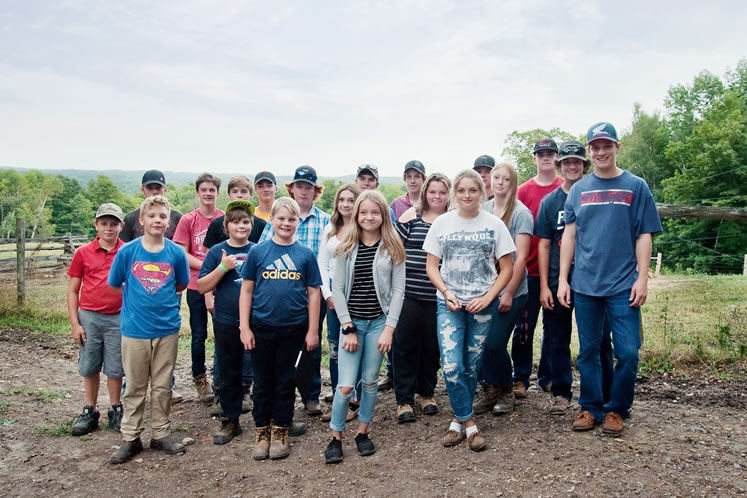
Members of the Dufferin 4-H Beef Club in the happy, chummy days of last summer – before Covid-19 obliged them to move their meetings online. Photo by Rosemary Hasner / Black Dog Creative Arts.
In Wellington County, for nearly 60 years, Switzer, a former school teacher, has seen and done it all in 4-H. From her start as a 12-year-old new member right through to being recognized in 2013 as national 4-H leader of the year, she has loved every minute of her involvement – and yes, she does have her childhood ribbons and trophies stashed somewhere.
A mother – and now grandmother – of 4-H kids, she has led clubs such as beef, photography, tractors, sewing, quilting, ploughing and fine arts. She has even created several. “In Lego engineering, we learned about gears and pulleys and solved engineering problems,” she said. Projects like this, dreamed up locally and submitted to the provincial body for approval, are encouraged.
In 2019, June led “cloverbuds,” a pre-4H club for children aged six to eight, as well as black light drama, cake decorating, woodworking and poultry clubs – and seems happily unfamiliar with the concept of free time.
In a church basement in a quiet hamlet tucked into northwest Erin, the soundtrack of the Mimosa 4-H Poultry Club’s first meeting of 2019 was the chatting of children and the chirpings of chicks.
“Black sex link,” said Switzer, referring not to a porn site, but to a breed of chicken. When Switzer mentioned the name, it drew no more giggles among a mixed group of rural eight- to 16-year-olds than did barred rock or light Sussex. “I didn’t expect it would,” she said. “If it had, I’d casually say, ‘Well, you obviously don’t know about chickens.’”
At the meeting, officers were nominated and elected, minutes were kept, a code of conduct signed. The club was split into smaller groups for activities and games that involved identifying breeds, judging henhouse apparatus, decorating eggs (Easter was imminent) and fun, high-fiving intergroup competition. Points were awarded and deducted with comic arbitrariness, and a “golden” egg filled with treats was the team prize for the evening.
“Competition is motivational and it’s fun,” said Switzer. “We bunch the kids up so there’s some of every age in each group [who named their teams the KFCs, the Cheesy Chickens, etc.] and so they’re not just with their friends. That allows for the kids who are shy or challenged in some way to work co-operatively, for everyone to have a role in their team. Leadership can come out of the shyest ones. Leadership is not about being bold, it’s about bringing out the best in your group, the best in you.”
Peeping black, grey and yellow day-old chicks with their egg tooth – a bump on the beak to aid cracking though an eggshell – still evident were distributed with much oohing and cooing. Each club member would nurture their chick or chicks to maturity and learn to groom, handle and show their bird in competition on achievement days at local fall fairs.
Popcorn and Skittles
Sam McLean, aged 12 at the time, in a worn ball cap and a sweatshirt garnished with agricultural firm logos, took two chicks and named them Popcorn and Skittles.
Sam wasn’t certain whether he’s a farm kid or a city kid, or if Popcorn and Skittles are pets or livestock. “A little bit of both” was his answer to both questions. Sam plays basketball and could have signed up for paintball club, but he chose poultry club and sheep club. “I just wanted to do farming activities.” His cousins had chickens and he thought he’d like to have some of his own.
Popcorn and Skittles started out in his mom’s suburban Orangeville home before moving to a small shed under a big willow in the backyard. A month or so later, when the chicks grew larger – and they did swiftly – and risked running afoul of town bylaws, they were relocated to a roomier, rustic coop on Sam’s dad’s 10-acre property in East Garafraxa.
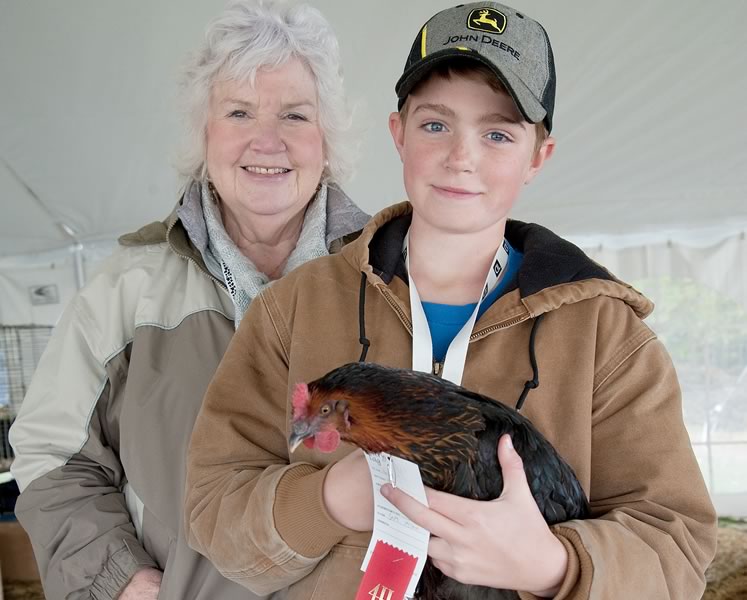
Longtime Wellington 4-H leader June Switzer and Sam McLean with Skittles, who took best in breed and best in show at the Fergus Fall Fair last year. Photo by Rosemary Hasner / Black Dog Creative Arts.
At subsequent poultry club meetings, Sam and his peers shared photos and reports of the progress of their growing birds, laughing, encouraging and learning equally from disasters and successes. There were the-dog-ate-my-bird excuses and shared intelligence on strategies, such as using an old-fashioned Vaseline rubdown as a remedy for lice now that access to some once-common lice powders is restricted. “Why would the powders be difficult to find, do you think?” June asked, with a nod to Socratic teaching. The answer? Because if not used properly, they could be harmful. And so it went.
Popcorn was becoming an elegant amber beauty – when not flapping in the barnyard dust. Sam’s hopes of winning awards were pinned on this atypical black sex link. “I think she’ll do well,” he said. But Skittles was also along for the ride. Sam fed the two carefully, groomed them with a toothbrush and habituated them to handling, which included spreading their wings to display plumage and bobbing their backsides to present their vent (where the egg comes from) to best advantage. He practised with both birds all summer.
In a cool drizzle at the 2019 Fergus Fall Fair, the poultry club’s season-ending public competition, Sam was looking miserable. Skittles, on the other hand, was looking great. A near-mature beauty, she gloried in her shiny black plumage with iridescent green undertones set off by a waterfall of amber at her neck.
“I got soaked, I’m freezing and I’m tired, but I guess it was a pretty good day,” Sam admitted as he huddled beneath a dripping awning after the competition. Surprisingly, it was Skittles’ cage that was decorated with red ribbons. Best in breed, best in show – as good as it gets! Judges praised Skittles’ generous comb, full breast, broad stance and well-developed plumage without gaps. Sam’s favoured bird, Popcorn, placed a respectable third in the field of 20, beating the likes of Cluck Berry and Darth Layer.
Switzer, bundled up and striding across sodden lawns, was quietly satisfied and visibly proud, praising the performances and participation of all the kids. As she always does. As she always will.
Even during this year’s pandemic.
The Mimosa 4-H Poultry Club carried on in 2020, though without Sam. Now a teen, he’s hoping to play baseball and basketball, but thinking of joining sheep club in 2021.
This year, following 4-H national protocols for masks and social distancing, Switzer raised and distributed chicks to club members, family by family, from her backyard.
Club lessons and quizzes are conducted online. Dividing the club into smaller units for in-person meetings – more meetings with smaller groups – is being discussed, because club meetings via Zoom proved to be challenging where rural high-speed internet is often sketchy. Achievement days have disappeared, along with fall fairs, of course, but alternative kids-and-parents-only outdoor gatherings are being considered.
“It has been a struggle,” said the indefatigable Switzer. “We’re limited, but we’re managing. We’re doing our best to carry on, but the social stuff, the leadership stuff, is what we’re really missing.” That and the hugs.
Maggi and Glam
For 16-year-old Maggi Murray, the restrictions on this year’s activities, as well as a part-time job, mean she hasn’t had as much time to devote to 4-H, so she hasn’t been visiting her great-aunt’s 230-acre beef farm as often as she did last year. The gravel drive leading into the farm is a kilometre long, and the views across Mulmur from its hilltop pastures must be 10 times that. When I arrived at the farm for a meeting of the Dufferin beef club last summer, Maggi, then 15, was wearing jeans in fashionable shreds. She had rope burns on her hands and, if you looked closely, a scar from a cow bite on her arm.
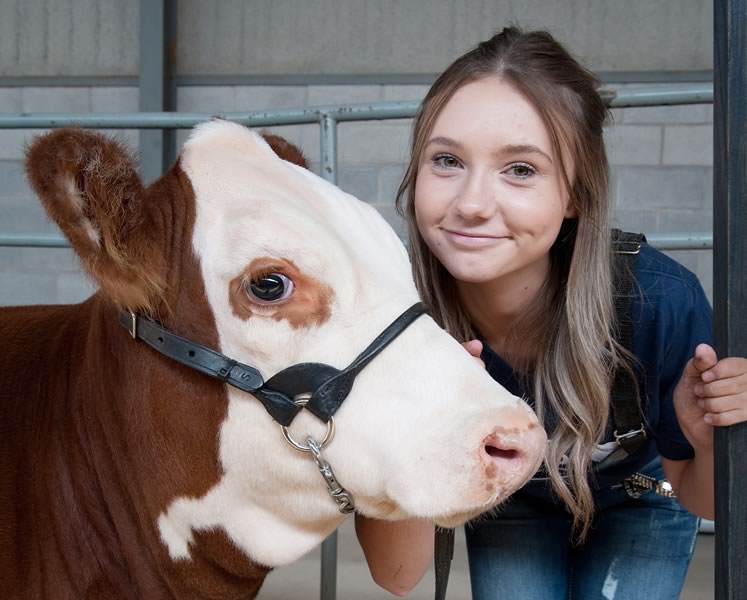
After a year of training in the Dufferin 4-H Beef Club, Maggi Murray and Glam took first place at the Orangeville Fall Fair in 2019. Photo by Rosemary Hasner / Black Dog Creative Arts.
At the time, Maggi would have liked to be swimming in the farm’s pond. Instead, she had spent the previous hour working with “Glam” – registered name Jdl Janice y79d 2031g – a 600-pound toddler in cattle terms, with a difficult disposition. “Working” refers to a bovine beauty parlour regimen of washing, shampooing (TRESemmé is favoured), blow-drying, combing, fluffing, teasing and clipping, as well as completing myriad minute primps seemingly fit for a supermodel.
Glam was unimpressed by it all and barely co-operative. She was even less so during a battle of wills with 110-pound Maggi over the following hour of show ring dry runs in an adjacent paddock.
The two- or three-times-a-week sessions in promenading and displaying her heifer were practice for the time Maggi and Glam would face the judges at the fall fair. Glam would be rated for physical conformation against a breed ideal, and Maggi would be judged on her poise in handling and her knowledge of Glam’s care and feeding. The idea is to control your animal confidently and pose it in the correct, aesthetically pleasing stance – in profile, front legs apart but parallel, one hind leg slightly ahead of the other, head raised showing a strong straight line from nose to tail, with good body mass showing no divots or flaws. In theory.
In practice, Glam, recently weaned and missing her mom, was at her most obstreperous – slobbering, pulling, declining to hold pose, and prone to tread on toes or kick. In a circling queue of a half-dozen heifers led by the other beef club kids, Glam stood out as the diva. She did like to have her belly scratched with the blunted hook of Maggi’s show stick, but she largely ignored the stick’s proddings.
“That’s it! They’ve had enough,” the club’s co-leader, Jessica Lasby, called out before the day, the animals and the kids got any hotter.
Lasby, in her mid-20s, has 4-H in her DNA. Her parents were in 4-H, and Lasby’s mother, Shirley, and brother, Justin, share leadership of the Dufferin beef club. Former club members themselves, the siblings have an impressive list of competition successes both locally and at the Royal Winter Fair in Toronto, the Olympics for Ontario livestock.
Earlier last summer, wearing a baggy sweatshirt and with a manure-smeared boot resting on a split rail fence, Lasby leaned down to work with a little girl daunted by a big cow and complicated judging criteria. The girl was school-aged, but couldn’t read. “So I adapt,” said Lasby. “We adapt so people don’t get singled out. It’s a challenge, but a good one. I’ll do it verbally. It’s easier for her, not as stressful.” Turning to the girl, she questioned, “That was good, but how do you say ‘bigger,’ ‘better’? How about ‘shows more growth for age’?” The little girl nodded and smiled. The cow pooped.
Patience is Lasby’s greatest skill as a leader. “Everyone learns at a different level,” she said. “We have competitive kids and kids who are just here for fun. Try to adapt your teaching style to individual members so they get out of it what they want. We put in a lot of work to help them reach any goals they may have. Maggi is competitive. We give her a good calf, we give her the tools to be successful. What she does with them is up to her. I’m confident Maggi can take anything into the show ring and make the animal look its best.”
And so she did.
Glam was on her best behaviour in Barn B at the 2019 Orangeville Fall Fair. Maggi wore a navy blue Dufferin 4-H Beef Club T-shirt, competitor bib number 10, a belt with lots of bling, and knots between her brows for most of the morning. She was nervous, fussing with Glam, raising, gluing and reclipping a stiff ridge of hair atop the heifer’s tail head until it was just so. Then thinking better of it and doing it again. “I’m sooo nervous,” she jittered.
In the centre of the show ring, a lean, solemn judge in cowboy hat and crisply pressed jeans stood motionless, his arms crossed, looking intently, giving nothing away. A couple of hundred silent spectators were equally intent in the stands. Lasby looked on, draped on a show ring gate, trying to appear casual.
The six competitors in the junior heifer class circled the judge, posed their animals, repeated and waited. Anticipating. No one smiled. The judge slowly walked down the line of competitors, making eye contact, asking questions, testing knowledge, learning whether each handler understood the care and feeding of a calf, and had not just “grabbed a halter” at the show. That the handlers had “done their job in the barn.”
Maggi had. Glam was named first in her class, and Maggi took the honours in showmanship. The choice was easy, according to the judge, who listed his reasons, including “more than eye-appeal.” Maggi was thrilled with her season-ending success. Lasby, who admits to being moved to tears on such occasions, was very proud.
Glam pooped.
After that eventful day, Glam and Maggi went on to become Ontario provincial reserve champions (second place) in the Hereford class at the Royal Winter Fair. Their partnership – as Glam matures, she is coming to accept that Maggi is in charge –continues in 2020. Maggi is still in the beef club, but the club experience has changed. Club meetings and season-ending competition are now conducted virtually because of Covid-19, but Maggi is content. “You can still learn,” she said. “I get to be close to agriculture. I’ll get to be a better farmer, maybe a better vet.”
And, as is the way in 4-H, a better person.
More Info
Related Stories

The Garden of Erin
Mar 26, 2018 | | FarmingTeens get the dirt on food and farming at Erin District High School.
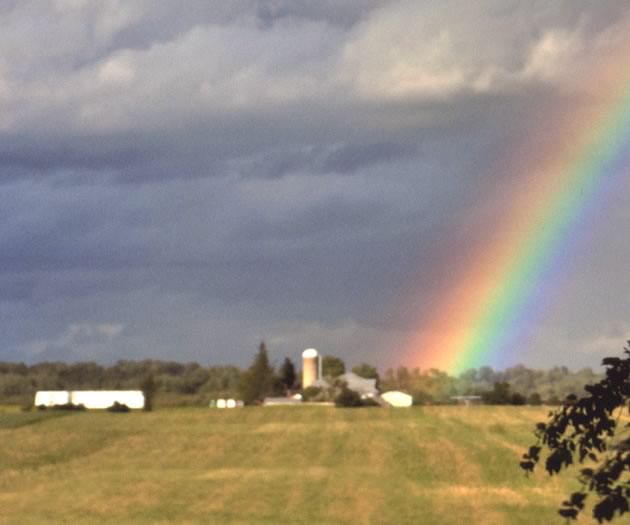
Dairy Herd SOLD
Mar 21, 2016 | | FarmingWith the dairy herd gone, a farmer’s daughter reflects on memory and identity.
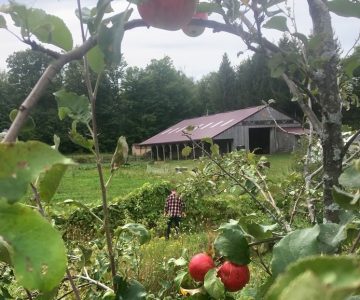
Imagining the Future
Jun 25, 2020 | | FarmingSo we wonder, amid the disruption and heartbreak, what future is being born in this moment?
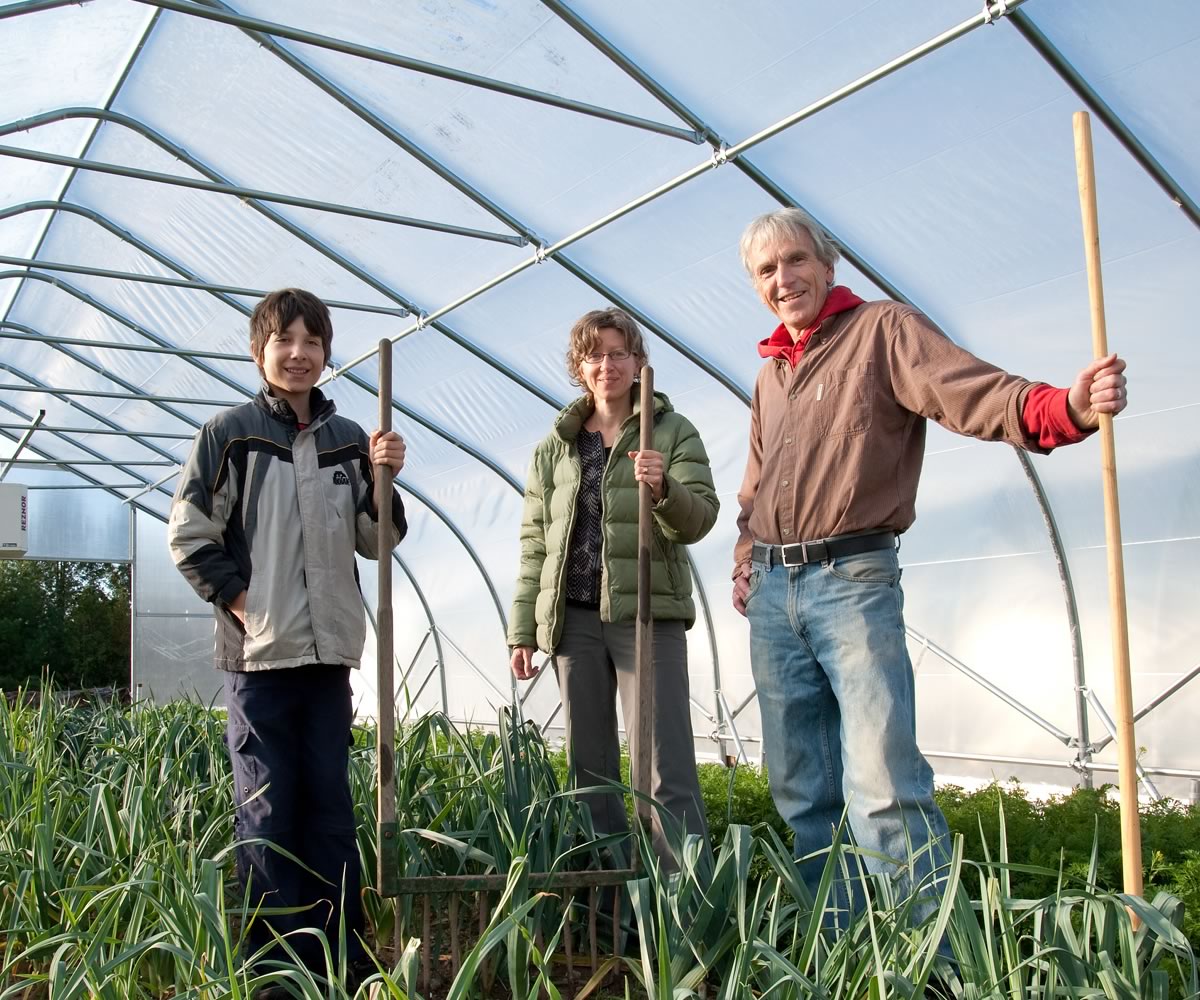
Am Braigh Farm: Farming on the Back Side of the Calendar
Nov 17, 2012 | | Homegrown in the HillsJamie bought Am Braigh’s three acres and broken-down old farmhouse in 1992. His aunt came up with the name, which is Gaelic for “higher ground,” relating both to his property and his spiritual leanings.








